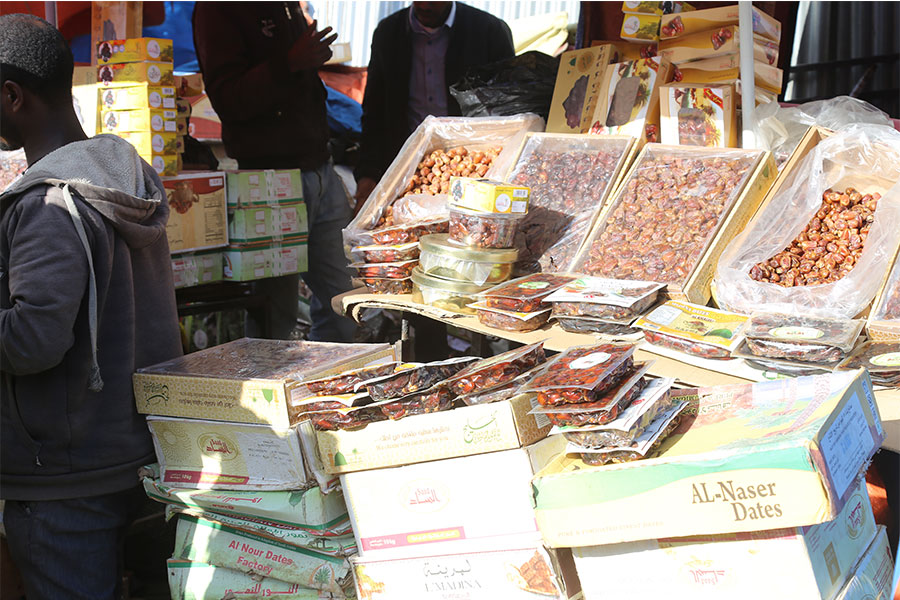
On the sunny Wednesday afternoon of May 17, 2020, the newly opened vegetable market in Jan Meda, which recently replaced the Atkilit Terra vegetable market, received few customers and fewer transactions.
Vegetable retailers met only a handful of buyers. Abebech Yilma, 38, was among them. She bought a kilogram of red onions and a kilogram of tomatoes for 30 and 22 Br, respectively.
Abebech, a resident of the capital, has found the cost of living unbearable since most of the food prices such as red onions have increased. Abebech is raising her two children on her 3,500 Br monthly income.
She used to consume a kilogram of red onions every week. Now, she is stretching each kilogram further.
“With the current price,” said Abebech. "I can’t consume a kilogram of red onions every week."
The price of red onions usually rises during the rainy season, but the current price is unprecedented. In mid-May, the cost of red onions increased from an average of 15 Br to 37 Br a kilogram. Depending on the place and type, a kilogram of red onions is being sold for 30 to 40 Br, a more than two-fold increase over the price a month ago.
This unexpected price hike is not only affecting the pockets of consumers but also retailers, who have witnessed the demand for the vegetable fall sharply.
Ibrahim Kedir, a red onion retailer in the Jan Meda open market, has observed this trend. He used to sell 10 quintals of red onions a day, but now he is retailing just five.
“Demand for my commodity has declined by half for the past three weeks,” he said. “Customers aren't coming like before.”
Ibrahim is buying the vegetable for 28 Br a kilogram from wholesalers who are located there and retailing for 30 Br a kilogram.
The price hike has led to less consumption and is also affecting the wholesalers. Ahmed Siraj is a wholesaler in Jan Meda. He used to sell 15 to 20ql of red onions a day, but now he is selling eight to 12 quintals for 2,800 Br each.
Ahmed’s stock was minimal up until two weeks ago. At this moment, his stock is full of the commodity. Too full.
“The price crisis has been followed by very little demand for the commodity, and the onions are decaying,” said Ahmed.
Both the city's trade bureau and the Ministry of Trade & Industry have recognised the latest supply shortage and the drastic price increase for the vegetable.
During the 2018/19 fiscal year, 2.6 million quintals of onions were produced on 28,185 hectares of land.
The price crisis is mainly attributed to market chain disruptions, according to Solomon Bekele, transaction director at the Addis Abeba Trade & Industry Development Bureau.
Every year during this season there is a supply shortage of red onions and other agricultural products in the capital, because heavy rainfall interrupts the flow of these products to Addis Abeba, according to Solomon.
“There is also a significant amount of wasted red onion production in the rainy season that contributes to the supply shortage in the market,” Solomon said.
The Ministry of Agriculture also disclosed that the rainy season is not known for the production of onions.
During the transition from the spring to the summer season, the production of red onions usually declines, because farmers plough and prepare the land for cereal crops, according to Desnet Belay, market research and promotion director at the Ministry of Agriculture.
“But this is typical; there are always seasonal fluctuations in red onion production,” said Desnet.
The area of land that is used for onion cultivation has declined in the past fiscal year from the preceding year. During the last fiscal year, 67,624 farmers cultivated 28,185ha of land with onions, an 11pc decline from the previous year. Productivity has also fallen by 10.7pc to 2.6 million quintals.
The main reason many farmers have stopped cultivating red onions is the high price of the hybrid red onion seed, according to Werake Redi, manager of Bereka Vegetables & Fruits Cooperative Union and an administrator of Ajira Kebelle in Silte Zone.
Previously, the government used to supply the farmers with hybrid red onion seeds from Europe. But now it has ceased to supply the seeds, leaving the farmers to buy them from private enterprises.
The farmers have been buying the hybrid seeds from Europe and Israel for 6,000 Br a kilogram, which is very productive, equating to 500ql to 600ql a hectare.
"We can buy it since the seed price is expensive," Werake said.
"Before, NGOs from Israel and Holland were giving us hybrid seeds. We used to buy a kilogram of local red onion seed for 1,000 Br, but the productivity of the local seeds have decreased from 380ql to 160ql a hectare," he said.
Demand fluctuations also compelled the farmers to switch to other crops. When the price of red onions was higher in the previous year, most of the farmers tended to plant red onions the following year. This brings excess supply, less demand, low prices and low return to the farmers.
“Many farmers have stopped planting red onions, because they are discouraged by these supply and demand fluctuations,” said Habtamu Abera, executive manager of Zengena Irrigation Development Cooperative Union, in Awi Zone, Amhara Regional State.
In this fiscal year, 36,373ha of land is estimated to be covered with onions, which are expected to yield 2.7 million quintals of the vegetable.
“However, seasonal production fluctuation isn't the main factor for the price hikes since supply shortages usually occur during this season,” said Eshete Asefa, state minister for Trade & Industry.
Due to the latest price escalation, the Ministry of Trade & Industry has assembled the National Task Force for Market Stabilisation to conduct an assessment on the causes of the red onion and tomato price increases. The Task Force identified that there is a shortage of red onion supply in the market.
On top of the seasonal production fluctuations, supply chain disruptions and illegal trading activities have contributed to the latest price hike, according to Eshete.
The assessment indicated that one of the reasons for the price increase was the interference of traders who are exporting onions abroad in legal and illegal ways, explained Eshete.
“We’re taking measures against traders and brokers who aggravate the problem,” said Eshete.
In May alone, 10,000ql of red onions were legally exported to Djibouti, Somalia and Kenya, according to Eshete, who added that 11 trucks transporting onions to Djibouti were caught in Dire Dawa last Friday.
The Ministry of Trade & Industry this week sanctioned the export of red onions to neighbouring countries because of the supply shortage in the domestic market. The Ministry ordered all customs stations to ensure that vegetables such as red onions and tomatoes are not exported abroad during times of high local demand.
“We then sent a letter to the Ministry of Revenues to stop the export of red onions and tomatoes,” Eshete said.
Another contributor to the shortfall in supply was the interruption of the import of red onions from Sudan due to the Novel Coronavirus (COVID-19) pandemic.
"The import of red onions will be resumed soon," said Eshete. “We’re working to ensure the continuation of the supply of red onions from Sudan.”
The ministries of Agriculture and Trade & Industry are currently conducting assessments on red onion production in Oromia, Southern Nations, Nationalities, & People's, and Amhara regional states.
The Ministry of Agriculture identified that low return on investment has made red onion a less popular crop with small-share farmers.
But these farmers are still getting the same value they were getting years ago, according to Desnet.
"The Ministry discovered that the middlemen get more value from the red onions than the farmers," says Desnet. “The brokers are highly networked and dictate the buying price for red onions from the small-scale and household farmers where the prices are low. This discourages the farmers from boosting red onion production.”
To encourage the small-scale farmers, the Ministry of Agriculture, after assessing the situation, came up with a new strategy for the farmers to increase the value of their products. It initiated the establishment of more producer unions and local organisational entities through which the producers of red onions and other agricultural products can lobby the prices for their commodities.
“These entities are initiated to make the farmers the price makers, not the price takers,” said Desnet.
To shorten the transaction chains and reduce the wasting of agricultural commodities, particularly red onions and tomatoes, the Federal Cooperative Agency has started providing logistical assistance to the producers and consumer unions, according to Usman Surur, director general at the Agency.
“We employed the connection between the farmer and consumer cooperative unions to stabilise the price and the market by decreasing transportation cost burdens on the producers,” said Usman.
The exclusion of intermediaries from the transaction will benefit the producers and consumers as the values that were going to the brokers will now go to the farmers and buyers, according to Mohammed Aman, an assistant professor of agricultural economics and agribusiness at Haramaya University.
“It can work for the time being but can’t be a sustainable solution to the fundamental problems of the sector," Mohammed said.
Mohammed argues that the principal factor for the problem is a supply shortage. There is steady growth in the agricultural sector, but there is also fast growth in demand for agricultural products.
The COVID-19 pandemic might bring about supply chain interruptions, according to Mohammed.
"The pandemic can easily disrupt the flow of products like red onions since it is a perishable good and producers can’t stock it," said Mohammed.
To reduce waste, the government should provide the farmers and their cooperative unions with storage and transportation facilities to supply their products to the market in the shortest possible time, according to the expert.
"There needs to be an authoritative institution in place of transparent information service about the market," said Mohammed. "Producers and consumers should be provided with information regarding the market to bring about smooth transactions."
The government should take action to stabilise the prices, because red onions are a basic commodity not a luxury, according to Mohammed.
“The government should also focus on the long-term solution - boosting agricultural productivity by giving incentives and introducing efficient and mechanised farming technologies,” Mohammed recommended.
PUBLISHED ON
Jun 20,2020 [ VOL
21 , NO
1051]

Radar | Nov 29,2020

Fortune News | Oct 19,2019

Agenda | Oct 31,2020

Featured | May 25,2019

Radar | Aug 21,2021

Dec 22 , 2024 . By TIZITA SHEWAFERAW
Charged with transforming colossal state-owned enterprises into modern and competitiv...

Aug 18 , 2024 . By AKSAH ITALO
Although predictable Yonas Zerihun's job in the ride-hailing service is not immune to...

Jul 28 , 2024 . By TIZITA SHEWAFERAW
Unhabitual, perhaps too many, Samuel Gebreyohannes, 38, used to occasionally enjoy a couple of beers at breakfast. However, he recently swit...

Jul 13 , 2024 . By AKSAH ITALO
Investors who rely on tractors, trucks, and field vehicles for commuting, transporting commodities, and f...

Jul 12 , 2025
Political leaders and their policy advisors often promise great leaps forward, yet th...

Jul 5 , 2025
Six years ago, Ethiopia was the darling of international liberal commentators. A year...

Jun 28 , 2025
Meseret Damtie, the assertive auditor general, has never been shy about naming names...

Jun 21 , 2025
A well-worn adage says, “Budget is not destiny, but it is direction.” Examining t...